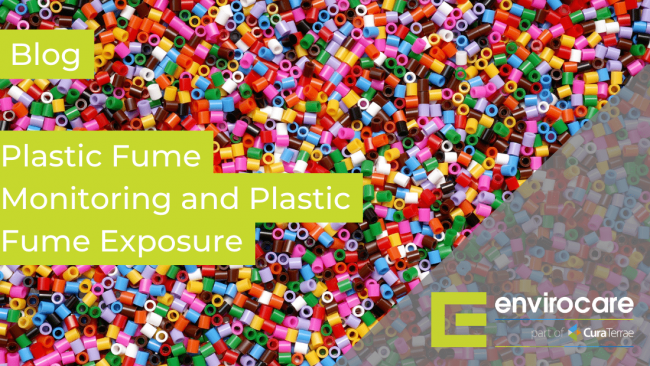Plastic Fume Monitoring and Plastic Fume Exposure
10 June 2015

There are numerous types of plastics used throughout industry in a range of applications. Plastics are generally based on polymers, which are large strands based on multiple units of small molecules. For example, polystyrene, which looks like this:
The plastic materials themselves are not an issue and from an occupational hygiene point of view, would need to be controlled at the nuisance dust level of 10mg/m3. The main point of concern regarding work in ‘plastic environments’ is exposure to by-products released during the manufacturing / processing of plastics. The most notable of scenario’s being fumes released during heat treatment of plastics. By-products include , but are not limited to, the following:
| Plastic | Constituents in fume | Common Uses |
| Acetals | Formaldehyde | Plastic Zippers, aerosol cans |
| Acrylonitrile Butadiene Styrene | Styrene, phenol, butadiene | Lego bricks, automotive trims |
| Polyethylene (low density) | Butane, other alkanes, alkenes | Packaging |
| PET Polyethylene Terephthalate | PAHs, styrene, aldehydes | Plastic bottles |
| Polypropylene | Formaldehyde, acrolein, acetone | Plastic hinges, plastic furniture |
| Polystyrene | Styrene, aldehydes | CD Cases, disposable razors |
| PVC Polyvinyl Chloride | Hydrogen chloride | Pipework, double glazing |
Plastic Fume Health Hazards
When plastic pellets, granules and powders are heated through processing, plastic fume can be produced which include respiratory sensitises, irritants and carcinogens being released into the working environment. Immediate effects of these may include severe irritation to the nose, lungs and eyes. In some cases, especially during prolonged exposures, the effects can be long term and irreversible.
Toxic gases emitted by burning plastic materials like dioxins and furans may also cause cancer, impotence, asthma and a myriad of other detrimental effects to human beings.
When carrying out a survey, testing would be conducted for the by-products rather than generic plastic fume. The production of plastic fume is affected by the material and the conditions under which the material is being processed, the maintenance level of the machine and the level of control of temperature.
What Can I Do About Plastic Fume Exposure?
First of all you will need an up to date COSHH Assessment. The most effective way of assessing exposure levels to plastic fume in the workplace is by air sampling. A popular way of doing this is by drawing a known quantity of air through a sorbent tube or filter, which is then analysed for contaminants known to be used in the process. Samplers can be fitted to operatives over the course of a day to determine personal exposure.
Following sampling, current working practices can be assessed and means of preventing or reducing exposure to hazardous substances by improving safety measures (protective equipment, PPE) and Control Strategies, such as local exhaust ventilation, can be implemented.
Plastic fume monitoring and measurement should be carried out at regular intervals, when processes change, when new plant or materials are introduced, or when new information comes to light regarding the substances used, such as a new or revised WEL.
Actions For The Control of Plastic Fume
- Get the MSDS for each material, and review on an annual basis to ensure the MSDS is up to date
- Review and update procedures based on updates to the MSDS
- Ensure operators are correctly trained in the procedures
- Check that machine alarms and cut-outs are working
- Ensure machines are kept clean and in a good state of repair
- Ensure LEV extraction systems are tested and serviced on at least an annual basis
- Carry out Air Sampling on a regular basis to determine levels of employee exposure
- Identify and mark all virgin and regrind materials clearly so that the wrong material/grade can’t be used by mistake.
- Check for visual signs of damage to thermocouples and leads. Procedures should be in place for regular inspection.
Experts In Plastic Fume Monitoring
Envirocare can provide assistance by carrying out independent UKAS accredited air quality testing and plastic fume monitoring within the plastics industry. Air monitoring work can provide a crucial part in aiding the production of your COSHH Risk Assessments.
Our service includes expert technical advice tailored to the needs of the individual plastic process, including the assessment of operative exposure to plastic fume ensuring levels are not above permitted workplace exposure limit values, the recommendation of further control measures to reduce the risk of ill health to your employees and workplace observations to ensure you meet your obligations in reducing exposure to as low as is reasonably practicable.
Call us on 01274 738668 or fill out our Envirocare Enquiry Form for any queries regarding plastic fume monitoring, workplace exposure limits and COSHH risk assessments.
This article was produced for Health and Safety Week 2015. Both the Health and Safety Executive and the British Plastics Federation offer additional information on the hazards of the plastic industry and what you can do to control them.
